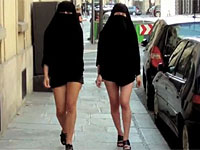Fashion Faux Pas as Resistant Force in France
Kathryn Montalbano: NiqaBitch, a YouTube video released shortly after France's September 2010 April 2011 official ban of face-covering head apparel, provides interesting if not deceptively complex social commentary expressed via the most fundamental medium for communication possible: the body itself. Although the video is set to what commenters call "vulgar" rap music (in English) and is plastered with French subtitles detailing the sometimes humorous dialogue (see below the photograph), undoubtedly observers—both within and of the video—are drawn to the remarkably stark, eye-catching juxtaposition of bare, toned female legs with shrouds that are, in Western minds, meant to hide sexuality.
Kathryn Montalbano: NiqaBitch, a YouTube video released shortly after France’s April 2011 official ban of face-coverings, provides interesting if not deceptively complex social commentary expressed via the most fundamental medium for communication possible: the body itself. Although the video is set to what commenters call “vulgar” rap music (in English) and is plastered with French subtitles detailing the sometimes humorous dialogue (see below the photograph), undoubtedly observers—both within and of the video—are drawn to the remarkably stark, eye-catching juxtaposition of bare, toned female legs with shrouds that are, in Western minds, meant to hide sexuality.
Observe around 1:52; translation of subtitles by Romain Géneaux:
Police: You cannot stay here.
Woman: Why, is it forbidden?
Police #1: No, no, but don’t stay; it is preferable.
Police #2: I love your outfit! Does it have to do with the law?
Woman: Yes, we want to defuse the situation.
Police #2: That’s great, can I take pictures of you?
Critiques of the ban are nothing new: there are those against nationalistic targeting of minorities (an unfortunately pervasive trend throughout much of Western Europe) and also those who claim to champion women’s rights and freedom. What’s particularly arousing about this video is the understated comment these women make on an over-publicized subject.
The women, strolling through the streets of Paris in niqābs paired with mini-shorts and 4-inch heels—an inversion of the state-approved communication—wave and pose for pictures by observers whose blacked-out faces are perhaps an ironic meta-criticism of the ban’s justification: that French societal communication is grounded in facial expression and recognition. The video’s YouTube comments demonstrate that the video effectively addresses Muslim women’s primary complaint: the ban “singles out and stigmatizes one gender of one religion.” Instead the video redirects the stigmatization toward the more Western women-baring-a-certain-kind-and-amount-of-skin-are-inherently-whores mentality (a stigma that is conveniently applicable to women of all religions).
Varying reactions to the female body, in “controversial” garb and/or exposing clothes, most acutely highlight the precariousness of nationally-imposed, legally-sanctioned cultural hierarchies. Any attempt to legislate appropriate from inappropriate, in from out, right from wrong, moral from immoral, sheds light on the absurdity of the ban.
As is quite clear by the women’s captivating legs, the niqābs fail to hide the feminine figures or, even the human bodies underneath the garments, banned for their impairment of view.
What, then, determines “effective” communication and deliberation in the eyes of the French state? A state notorious for its history of sanctioning acceptable “mainstream” media, dating back to the Old Regime whose censorship of texts, from pornography to political satire, resulted in the creation of a literary black market?
Sure, just as the women altered the typical presentation of the niqāb by selecting sexually-stimulating pieces, the display could have been indefinitely tweaked and edited to slightly alter the overarching message (such as if the background music were slightly less obtrusive or in another language or if the women wore flats rather than heels). But using hyperbolic signifiers to address the ban’s underlying absurdity certainly got a point across, even if that point is not quite clear. And perhaps that is the point.
